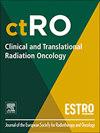乳房切除术后质子或光子放射治疗的即时2期乳房重建结果
IF 2.7
3区 医学
Q3 ONCOLOGY
引用次数: 0
摘要
目的探讨乳房切除术后放射治疗(PMRT)对质子或光子放射治疗患者即刻乳房重建(IBR)结果的影响。材料和方法回顾性分析我院行乳房切除术、即刻乳房重建和PMRT的患者手术部位感染(SSI)、计划外再手术和重建失败的危险因素。单变量Cox模型用于检验变量与重建结果的关联。结果纳入231名妇女,其中224名(97.0%)接受了两期IBR并放置组织扩张器,7名(3%)接受了直接植入IBR。165例(71.4%)接受质子治疗,65例(28.6%)接受光子治疗。29例(12.6%)患者接受了低分割术。中位随访时间为1.8年。两年累积SSI风险为17.83% (95% CI 12.27 - 24.41%);计划外再手术占16.19% (95% CI 10.06 ~ 22.10%);重建失败率为7.60% (95% CI 3.55 ~ 12.11)。在多变量分析中,预防性使用Mepitel Film降低了SSI的风险[HR: 0.35 (95% CI: 0.18-0.69), p = 0.002]和计划外再手术的风险[HR: 0.39 (95% CI: 0.20-0.79), p = 0.008]。事件数量少(n = 16)排除了重建失败的多变量分析;在单因素分析中,胸壁增强[风险比:4.98 (95% CI: 1.12-22.10), p = 0.035]和/或淋巴结增强[风险比:3.66 (95% CI: 1.25-10.73), p = 0.018]与重建失败相关。结论:尽管约五分之一的女性经历过SSI或计划外的再手术,但重建失败率很低(7.6%),大多数女性使用光子或质子进行PMRT成功重建。较低的SSI发生率和使用Mepitel膜的意外再手术突出了进一步评估的必要性。本文章由计算机程序翻译,如有差异,请以英文原文为准。
Immediate 2-Stage breast reconstruction outcomes after proton or photon postmastectomy radiotherapy
Purpose
To evaluate the impact of postmastectomy radiotherapy (PMRT) on immediate breast reconstruction (IBR) outcomes among patients treated with proton or photon radiotherapy.
Material and Methods
Patients who had undergone mastectomy, immediate breast reconstruction, and PMRT at our institution were included in a retrospective analysis of risk factors for surgical site infection (SSI), unplanned reoperation, and reconstruction failure. Univariate Cox models were used to examine associations of variables with reconstruction outcomes.
Results
Two-hundred thirty-one women were included, of whom 224 (97.0 %) underwent two-stage IBR with placement of a tissue expander and 7 (3 %) had direct-to-implant IBR. One-hundred sixty-five patients (71.4 %) received proton and 65 (28.6 %) received photon therapy. Twenty-nine patients (12.6 %) received hypofractionation. Median follow-up was 1.8 years. Two-year cumulative risk of SSI was 17.83 % (95 % CI 12.27–24.41 %); unplanned reoperation was 16.19 % (95 % CI 10.06–22.10 %); and reconstruction failure was 7.60 % (95 % CI 3.55–12.11). On multivariable analysis, prophylactic use of Mepitel Film reduced the risk of SSI [HR: 0.35 (95 % CI: 0.18–0.69), p = 0.002] and unplanned reoperation [HR: 0.39 (95 % CI: 0.20–0.79), p = 0.008]. The small number of events (n = 16) precluded multivariable analysis of reconstruction failure; on univariate analysis, receipt of a chest wall boost [HR: 4.98 (95 % CI: 1.12–22.10), p = 0.035] and/or lymph node boost [HR: 3.66 (95 % CI: 1.25–10.73), p = 0.018] were associated with reconstruction failure.
Conclusions
Although approximately one-fifth of women experienced SSI or unplanned reoperation, the rate of reconstruction failure was low (7.6%) and most women achieved a successful reconstruction outcome with PMRT using photons or protons. The lower rate of SSI and unplanned reoperation with use of Mepitel Film highlights the need for further evaluation.
求助全文
通过发布文献求助,成功后即可免费获取论文全文。
去求助
来源期刊

Clinical and Translational Radiation Oncology
Medicine-Radiology, Nuclear Medicine and Imaging
CiteScore
5.30
自引率
3.20%
发文量
114
审稿时长
40 days
 求助内容:
求助内容: 应助结果提醒方式:
应助结果提醒方式:


